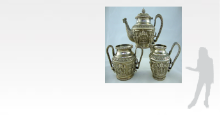
Lot
49
of
60

SILVER FROM THE INDIAN SUB-CONTINENT 1858-1947
ARTWORK DETAILS
-
-
Madras Three Piece "Swami Ware" Tea Set, Attributed to P.Orr & Sons
-
-
c. 1880
-
Width: 20.3 cm (Teapot)
Total Weight: 1163 g
-
Madras, located in south eastern India, was one of the most significant cities in India under the British administration. The finest pieces of Madras silver were produced by Indian craftsmen working for European-run firms, unlike the silver produced in other regions of India which was crafted by independent craftsmen. The largest European firm was P. Orr & Sons of Madras; they were responsible for the encouragement of the 'swami' style of decoration. 'Swami'ornamentation depicts Hindu deities and mythological figures, and the style was a huge success in Europe and Great Britain. Despite European market trends, the silversmiths of Madras established a strong indigenous style which concentrated on the traditional illustration of their gods.
Swami designs were deep, and exhibited fine and intricate detailing, which enabled the specific figures to be easily identifiable. The Hindu tradition of religious art comprises the images of deities, illustrations of characters and episodes from epics like the Ramayana. The stories of the ten avatars of Vishnu are some of the most popular depictions in the silverware from this region.
The most frequent deities represented in Madras silverware are Vishnu, Shiva, Parvati, Brahma and Surya. Also depicted are Angi, Brahma, Durga, Ganesh, Indra, Kali, Kama, Parvati, Shiva, Vishnu, and Yama; most of the gods are riding their vahana, or their associated animal, in these depictions.
P. Orr & Sons of Madras was the most popular silver firm in South India in the 19th century. Its silverware was chosen as a present for the Prince of Wales during his visit to India in 1875-1876, and thanks to the appreciation of this firm by the Prince, P. Orr & Sons were appointed "Jewellers and Silversmiths to His Royal Highness the Prince of Wales", on 22 April 1876.
Madras was the main trading settlement founded by the British in 1644, and for this reason the best silver craftsmen were protected by European firms. By 1880, P. Orr & Sons became very successful and supplied European, Australian and American markets. P. Orr was also responsible for new legislation enacted in 1884, enabling the import of silver to Great Britain under regulations.
The main characteristic of P. Orr silver was the juxtaposition of European shapes with Indian patterns and designs. They often represented gods, 'swamis', or traditional Indian myths and, as a result, P. Orr silverware is also referred to as 'swami' on occasion.
-
Category: Jewelry
Style: Figurative
-

Height of Figure: 6'